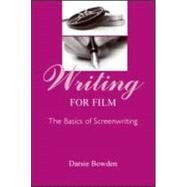
Note: Supplemental materials are not guaranteed with Rental or Used book purchases.
Purchase Benefits
What is included with this book?
| Preface | p. xi |
| The Dramatic Film | |
| The Rhetoric of the Screenplay | p. 3 |
| Introduction: What Does it Mean to Write for the Movies? | p. 3 |
| Some General Guidelines | p. 7 |
| Screenwriting Versus Literary Writing | p. 14 |
| The Road to Success | p. 19 |
| Applications and Exercises | p. 19 |
| Suggested Reading | p. 21 |
| The Film Drama | p. 23 |
| What Is a Good Idea? | p. 24 |
| What Is a Good Story? | p. 25 |
| Plot | p. 30 |
| Filmic Structure | p. 42 |
| Ready to Go | p. 54 |
| Applications and Exercises | p. 54 |
| Suggested Reading | p. 55 |
| Character | p. 57 |
| What Is an Effective Character? | p. 57 |
| Types of Characters | p. 58 |
| How to Create a Good Character | p. 61 |
| What Is Effective Dialogue? | p. 69 |
| Applications and Exercises | p. 87 |
| The Nuts and Bolts of Screenplay Format | p. 89 |
| Some General Rules | p. 89 |
| The Mechanics of Screenplay Form | p. 91 |
| Checklist | p. 107 |
| Applications and Exercises | p. 111 |
| Suggested Reading | p. 114 |
| Crafting Your Screenplay (Brilliance With Just a Little Extra Effort) | p. 115 |
| All-Purpose Principles for Writing That Dazzles and Impresses | p. 116 |
| Quick and Dirty Troubleshooting Tips | p. 120 |
| Style | p. 121 |
| Final Notes on Revising | p. 144 |
| Applications and Exercises | p. 145 |
| Suggested Reading | p. 146 |
| Selling Your Screenplay | p. 147 |
| Potential Players | p. 147 |
| Presenting Your Material | p. 152 |
| Screenplay Scenarios | p. 164 |
| The Follow-Through-After the Script Is Completed | p. 166 |
| The Writers Guild of America | p. 169 |
| The Measure of Success | p. 172 |
| Suggested Reading | p. 173 |
| Applying Dramatic Principles | |
| Adaptations | p. 177 |
| Distinctions Between Literary Fiction and Screenplays | p. 177 |
| The Process of Adaptation | p. 179 |
| Adapting Plays | p. 197 |
| Adaptations and the Creative Process | p. 198 |
| Applications and Exercises | p. 199 |
| Suggested Reading | p. 201 |
| The Fact Film: Documentaries-Form and Format | p. 203 |
| What Is a Documentary Film? | p. 203 |
| Writing a Documentary Film | p. 206 |
| Sample Proposals | p. 213 |
| A Sample Treatment | p. 218 |
| The Documentary Screenplay | p. 221 |
| Notes on Style in Documentary Writing | p. 225 |
| Dialogue and Narration | p. 226 |
| Screenplay Format | p. 228 |
| Troubleshooting | p. 234 |
| Audience | p. 236 |
| Applications and Exercises | p. 237 |
| For Viewing | p. 237 |
| Suggested Reading | p. 239 |
| Marketplace: Screenplay for Films That Inform, Explain, and Sell | p. 241 |
| The Communication Triangle | p. 243 |
| Format | p. 254 |
| Finding a Market | p. 256 |
| A Final Comment | p. 257 |
| Applications and Exercises | p. 257 |
| Introduction to the Experimental Film | p. 259 |
| What Is an Experimental Film? | p. 261 |
| Writing and Designing an Experimental Film | p. 265 |
| What Is a Good Idea for an Experimental Film? | p. 267 |
| Work With the Medium | p. 267 |
| Market | p. 270 |
| Form and Format | p. 272 |
| Why Bother? | p. 281 |
| Experimental Films as Art | p. 281 |
| Applications and Exercises | p. 281 |
| Suggested Reading | p. 282 |
| Epilogue | p. 283 |
| Appendix | p. 285 |
| General References | p. 291 |
| Author Index | p. 297 |
| Subject Index | p. 299 |
| Table of Contents provided by Ingram. All Rights Reserved. |
The New copy of this book will include any supplemental materials advertised. Please check the title of the book to determine if it should include any access cards, study guides, lab manuals, CDs, etc.
The Used, Rental and eBook copies of this book are not guaranteed to include any supplemental materials. Typically, only the book itself is included. This is true even if the title states it includes any access cards, study guides, lab manuals, CDs, etc.